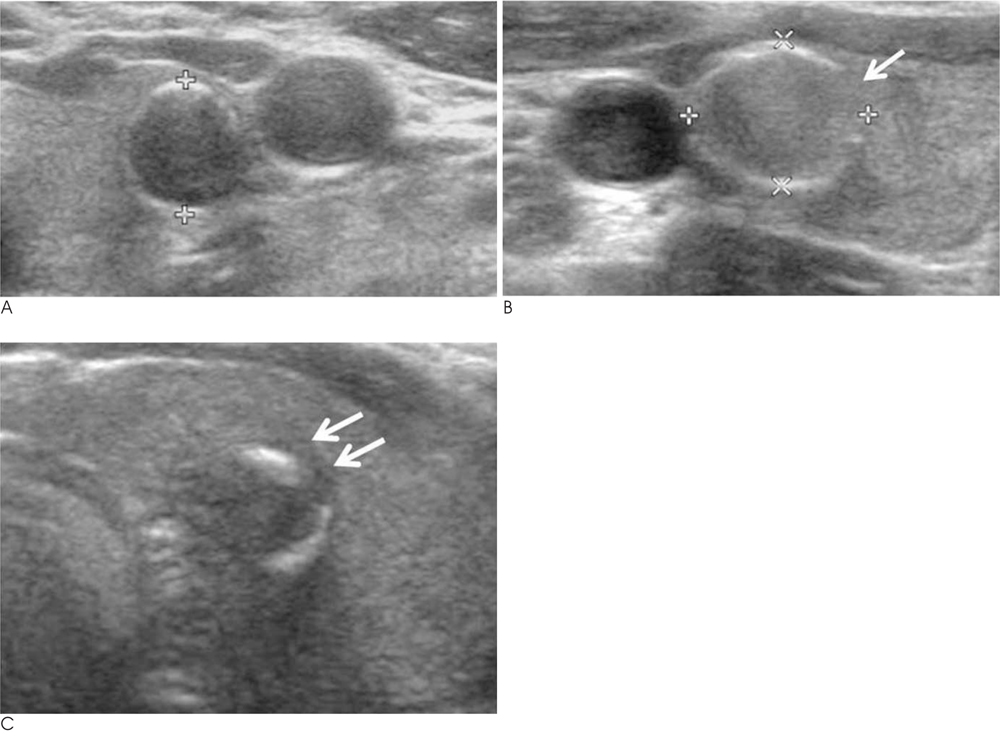J Korean Soc Radiol.
2011 Jun;64(6):531-535. 10.3348/jksr.2011.64.6.531.
Comparative Study of US Features, US-guided Fine Needle Aspiration Cytology, and Pathology Results for Eggshell Calcified Thyroid Nodules
- Affiliations
-
- 1Department of Radiology, Busan Paik Hospital, Inje University College of Medicine, Korea. dwultra@lycos.co.kr
- KMID: 1443501
- DOI: http://doi.org/10.3348/jksr.2011.64.6.531
Abstract
- PURPOSE
The aim of this study was to investigate ultrasound (US) findings of eggshell calcified thyroid nodules associated with thyroid malignancy and the diagnostic usefulness for US-guided fine-needle aspiration cytology (US-FNAC) of eggshell calcified thyroid nodules.
MATERIALS AND METHODS
We analyzed 36 eggshell calcified thyroid nodules in 35 patients who underwent thyroid US and US-FNAC from January to December of 2009. We compared the US findings and US-FNAC results with the pathologic results confirmed by surgery.
RESULTS
Twenty eggshell calcified nodules were surgically removed in 19 patients, from which 8 papillary thyroid carcinomas and 12 hyperplasia nodules were confirmed. The sensitivity, specificity, positive, and negative predictive values, as well as accuracy for US diagnosis and US-FNAC of eggshell calcified nodules were 100% and 20%, 25% and 100%, 43.8% and 100%, 100% and 63.6%, and 55% and 66.7%, respectively.
CONCLUSION
The results of this study indicate that thick peripheral hypoechoic rim and thickening of eggshell calcified nodules are significantly related to malignancy, but focal disruption of eggshell calcification is not.
MeSH Terms
Figure
Reference
-
1. Kwak MS, Baek JH, Kim YS, Jeong HJ. Patterns and Significance of Peripheral Calcifications of Thyroid Tumors seen on Ultrasound. J Korean Radiol Soc. 2005; 53:401–405.2. Yoon DY, Lee JW, Chang SK, Choi CS, Yun EJ, Seo YL, et al. Peripheral calcification in thyroid nodules: ultrasonographic features and prediction of malignancy. J Ultrasound Med. 2007; 26:1349–1355.3. Kim BM, Kim MJ, Kim EK, Kwak JY, Hong SW, Son EJ, et al. Sonographic differentiation of thyroid nodules with eggshell calcifications. J Ultrasound Med. 2008; 27:1425–1430.4. Park M, Shin JH, Han BK, Ko EY, Hwang HS, Kang SS, et al. Sonography of thyroid nodules with peripheral calcifications. J Clin Ultrasound. 2009; 37:324–328.5. Wang N, Xu Y, Ge C, Guo R, Guo K. Association of sonographically detected calcification with thyroid carcinoma. Head Neck. 2006; 12:1077–1083.6. Choi JO, Lee JY, Chung K, Choi G. Patterns of Calcification in Thyroid Nodules: Significance and Malignanat Potnetiality. Korean J Head Neck Oncol. 1997; 13:30–34.7. Khoo ML, Asa SL, Witterick IJ, Freeman JL. Thyroid calcification and its association with thyroid carcinoma. Head Neck. 2002; 24:651–655.8. Yang YS, Lim HS, Kim YW, Oh JK, Hong KH. The Relative Risk of Cancer in Sonographically Detected Thyroid Nodules with Calcifications. Korean J Otolaryngol-Head Neck Surg. 2004; 47:457–461.9. Seibering KA, Dutra JC, Grant T, Bajramovic S. Role of intrathyroidal calcifications detected on ultrasound as a marker of malignancy. Laryngoscope. 2004; 114:1753–1757.10. Kakkos SK, Scopa CD, Chalmoukis AK, Karachalios DA, Spiliotis JD, Harkoftakis JG, et al. Relative risk of cancer in sonographically detected thyroid nodules with calcifications. J Clin Ultrasound. 2000; 28:347–352.11. Koike E, Noguchi S, Yamashita H, Murakami T, Ohshima A, Kawamoto H, et al. Ultrasonographic characteristics of thyroid nodules: prediction of malignancy. Arch Surg. 2001; 136:334–337.12. Kim EK, Park CS, Chung WY, Oh KK, Kim DI, Lee JT, et al. New sonographic criteria for recommending fine-needle aspiration biopsy of nonpalpable solid nodules of the thyroid. AJR Am J Roentgenol. 2002; 178:687–691.13. Frates MC, Benson CB, Charboneau JW, Cibas ES, Clark OH, Coleman BG, et al. Management of thyroid nodules detected at US: society of radiologists in ultrasound consensus conference statement. Radiology. 2005; 237:794–800.14. Moon WJ, Baek JH, Jung SL, Kim DW, Kim EK, Kim JY, et al. Ultrasonography and ultrasound-based management of thyroid nodules: consensus statement and recommendations. Korean J Radiol. 2011; 12:1–14.
- Full Text Links
- Actions
-
Cited
- CITED
-
- Close
- Share
- Similar articles
-
- Thyroid nodules with discordant results of ultrasonographic and fine-needle aspiration findings
- Natural Course of Cytologically Diagnosed Benign Thyroid Nodules
- Fine Needle Aspiration Cytology of Thyroid Follicular Proliferative Lesions
- Thyroid Fine-Needle Aspiration in Taiwan: The History and Current Practice
- Follow-up of benign thyroid nodules confirmed by ultrasound-guided core needle biopsy after inconclusive cytology on fine-needle aspiration biopsy



